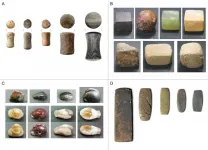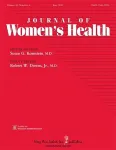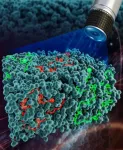(Press-News.org) Natural wood remains a ubiquitous building material because of its high strength-to-density ratio; trees are strong enough to grow hundreds of feet tall but remain light enough to float down a river after being logged.
For the past three years, engineers at the University of Pennsylvania's School of Engineering and Applied Science have been developing a type of material they've dubbed "metallic wood." Their material gets its useful properties and name from a key structural feature of its natural counterpart: porosity. As a lattice of nanoscale nickel struts, metallic wood is full of regularly spaced cell-sized pores that radically decrease its density without sacrificing the material's strength.
The precise spacing of these gaps not only gives metallic wood the strength of titanium at a fraction of the weight, but unique optical properties. Because the spaces between gaps are the same size as the wavelengths of visible light, the light reflecting off of metallic wood interferes to enhance specific colors. The enhanced color changes are based on the angle that light reflects off of the surface, giving it a dazzling appearance and the potential to be used as a sensor.
Penn Engineers have now solved a major problem preventing metallic wood from being manufactured at meaningful sizes: eliminating the inverted cracks that form as the material is grown from millions of nanoscale particles to metal films big enough to build with. Preventing these defects, which have plagued similar materials for decades, allows strips of metallic wood to be assembled in areas 20,000 times greater than they were before.
James Pikul, assistant professor in the Department of Mechanical Engineering and Applied Mechanics, and Zhimin Jiang, a graduate student in his lab, have published a study demonstrating this improvement in the journal Nature Materials.
When a crack forms within an everyday material, bonds between its atoms break, eventually cleaving the material apart. An inverted crack, by contrast, is an excess of atoms; in the case of metallic wood, inverted cracks consist of extra nickel that fills in the nanopores critical to its unique properties.
"Inverted cracks have been a problem since the first synthesis of similar materials in the late 1990s," says Jiang. "Figuring out a simple way of eliminating them has been a long-standing hurdle in the field."
These inverted cracks stem from the way that metallic wood is made. It starts as a template of nanoscale spheres, stacked on top of one another. When nickel is deposited through the template, it forms metallic wood's lattice structure around the spheres, which can then be dissolved away to leave its signature pores.
However, if there are any places where the spheres' regular stacking pattern is disrupted, the nickel will fill those gaps, producing an inverted crack when the template is removed.
"The standard way to build these materials is to start with a nanoparticle solution and evaporate the water until the particles are dry and regularly stacked. The challenge is that the surface forces of water are so strong that they rip the particles apart and form cracks, just like cracks that form in drying sand," Pikul says. "These cracks are very difficult to prevent in the structures we are trying to build, so we developed a new strategy that allows us to self-assemble the particles while keeping the template wet. This prevents the films from cracking, but because the particles are wet, we have to lock them in place using electrostatic forces so that we can fill them with metal."
With larger, more consistent strips of metallic wood now possible, the researchers are particularly interested in using these materials to build better devices.
"Our new manufacturing approach allows us to make porous metals that are three times stronger than previous porous metals at similar relative density and 1,000 times larger than other nanolattices," Pikul says. "We plan to use these materials to make a number of previously impossible devices, which we are already using as membranes to separate biomaterials in cancer diagnostics, protective coatings and flexible sensors."
INFORMATION:
This work was partially funded by the pilot grant program from the Center for Innovation & Precision Dentistry at the University of Pennsylvania and by the National Science Foundation under CAREER Grant No. 1943243.
Knowing the weight of a commodity provides an objective way to value goods in the marketplace. But did a self-regulating market even exist in the Bronze Age? And what can weight systems tell us about this? A team of researchers from the University of Göttingen researched this by investigating the dissemination of weight systems throughout Western Eurasia. Their new simulation indicates that the interaction of merchants, even without substantial intervention from governments or institutions, is likely to explain the spread of Bronze Age technology to weigh goods. The results were ...
Keep your checklists handy because the 62nd Supplement to the American Ornithological Society's Check-list of North American Birds, publishing today in Ornithology, includes numerous updates to the classification of the continent's bird species. A few highlights from this year's supplement, detailed below, include species splits for Mew Gull, Barred Owl, and Sedge Wren, among quite a few others; a transfer back to an old genus for Ruby-crowned Kinglet; and a revision of the linear sequence of passerine families. The Check-list, published since 1886, is updated annually by the AOS's North American Classification Committee (NACC), the official authority on the names and ...
RICHLAND, Wash.--Researchers have increased the lifetime of a promising electric vehicle battery to a record level, an important step toward the goal of lighter, less expensive and long-lasting batteries for future electric vehicles. The work is reported June 28 in the journal Nature Energy.
Such batteries--the goal of research groups the world over--are seen as an important part of the solution to reduce the effects of climate change, and scientists are exploring a dizzying array of options.
One solution on the horizon is a lithium-metal battery for electric vehicles. These ...
(San Antonio, June 29, 2021) - UTSA criminology and criminal justice professors Michael R. Smith and Rob Tillyer working in collaboration with University of Cincinnati Professor Robin Engel examined racial and ethnic disparities in the use of force by the Fairfax County Police Department (FCPD). One of the nation's largest county police departments, the FCPD serves Fairfax County, Va., a major metropolitan county near Washington, D.C.
The team presented the results of its 18-month study today to the Public Safety Committee of the Fairfax County Board of Supervisors. ...
The historic 2020 hurricane season, with its record-breaking 30 tropical storms and hurricanes, left in its wake hundreds of deaths in the United States, tens of billions of dollars in damages, and one important question: Is this what the future will look like?
While most climate scientists agree that hurricane severity, at least in terms of rainfall, will likely increase as the planet warms, there remains uncertainty about the future frequency of hurricanes. Today's climate models offer a range of possible futures, some predicting an increase in North Atlantic hurricane frequency, others a decrease. These conflicting results beg the question: are these ...
HOUSTON - (June 29, 2021) - When you think about trade and market relationships, you might think about brokers yelling at each other on the floor of a stock exchange on Wall Street. But it seems one of the basic functions of a free market is quietly practiced by fungi.
New research from a Rice University economist suggests certain networks of fungi embrace an important economic theory as they engage in trading nutrients for carbon with their host plants. This finding could aid the understanding of carbon storage in soils, an important tool in mitigating climate change.
A research paper entitled "Walrasian equilibrium behavior in nature" is available online and will appear in an upcoming edition of Proceedings of the National Academy of Sciences. Ted Loch-Temzelides, ...
Among low-income, uninsured, or publicly insured women ages 25-64 years who were not up to date on cervical cancer screening, 72% perceived financial barriers to screening. The most commonly reported barriers were screening appointment costs (71%) and follow-up/future treatment costs (44%), according to a study published in the peer-reviewed Journal of Women’s Health. Click here to read the article now.
Screening is effective at reducing the incidence of and mortality associated with cervical cancer. However, disparities exist in cervical cancer incidence and mortality and in cervical cancer screening based ...
Langerhans cell histiocytosis (LCH) is a rare cancer involving dendritic cells, a type of white blood cell that usually helps defend against infections. The current standard of care for LCH, chemotherapy, cures fewer than half of patients.
"Our research team focuses on identifying the causes of LCH so that we can develop better therapies for patients," said Dr. Rikhia Chakraborty, assistant professor of pediatrics - hematology and oncology at Baylor College of Medicine.
Most cells in LCH lesions are not abnormal dendritic cells but other invading immune cells, such as T cells, that are recruited to sites of disease. The contribution of T cells and other immune cells to LCH disease is not known. Chakraborty and her team at the Texas Children's Cancer Center Histiocytosis Program characterized ...
Mate choice is important for females, who often invest much more energy in offspring than males. However, being too selective is a bad idea, as they might end up not mating at all. Biologists have wondered for a long time how females optimize their chances. Scientists at the University of Groningen have performed experiments with fruit flies that reveal the explanation: mating induces a behavioural change in female flies that makes them more choosy than when they are virgins. The results were published on 21 June in Nature Ecology and Evolution.
The fourteenth-century French philosopher Jean Buridan described a donkey who starved to death because he couldn't choose between two bales of hay. Evolutionary biologists have their own version of this decision-making ...
University of Colorado Boulder researchers have discovered that minuscule, self-propelled particles called "nanoswimmers" can escape from mazes as much as 20 times faster than other, passive particles, paving the way for their use in everything from industrial clean-ups to medication delivery.
The findings, published this week in the Proceedings of the National Academy of Sciences, describe how these tiny synthetic nanorobots are incredibly effective at escaping cavities within maze-like environments. These nanoswimmers could one day be used to remediate contaminated ...





